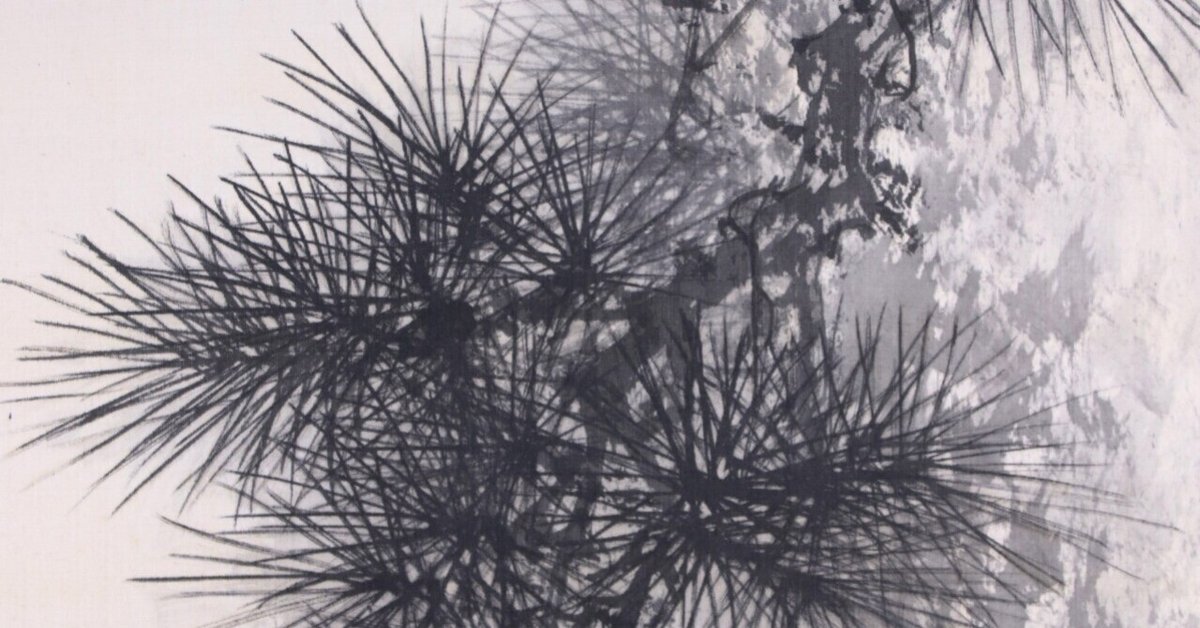
今尾景年 作 千歳松図
今尾景年 作
(Imao Kenen)
千歳松図
(Chitose pine)
暑い日が続きますが、掛軸の土用干しにはうってつけなので、頑張っています。丁度、景年さんの千歳松を干しているので、今回、この画を紹介します。
まず、今尾景年と言えば、木島桜谷の師匠であり、円山派の重鎮の一人です。詳しいお話は後で書きますが、当時は凄い人でした。今は忘れられてかけていますので、是非、覚記憶に留めていただければと思っています。
1915年、大正天皇の即位の礼が行われた際、錦軟障に景年は「千年松山水図」を描いています。この時の余墨を使って、この千歳松図は描かれています。
この松図は墨だけで描かれているのですが、松の緑の色を頭の中で想像してしまうぐらい引き込まれます。松葉の描き方が非常に繊細で、葉先まで神経を尖らせて描いているので、そう感じてしまうのかもしれませんね。しかし、墨だけで、しかも、松だけでここまで描けるのは、本当に感心してしまいます。
今尾景年
初めは浮世絵師の梅川東居について学び、その後、鈴木百年の門下となって景年の号を使用し始める。
禁門の変で実家を焼失し、また、明治初期の日本画の不遇の時代もあり、当初は生家の家業であった友禅図案、上絵描きの仕事をしながらの絵画の研究を行っていた。1868年の父の死亡を機に画業に専念する。
明治前半期は京都博覧会、内国共進会、日本美術協会などによく出品して受賞を続け、京都画壇を中心に人気画家として名を上げていった。その後、1893年のシカゴ万博に「鷲猿図」を出品し、その緻密な描写に対して高い評価がなされ、名誉賞牌を受賞する。次いで1900年のパリ万博の「春山花鳥図」、03年のセントルイス万博「四季花鳥図」で金牌を受賞し、世界的に高い評価を得た。04年には望月玉泉とともに帝室技芸員を拝命され、19年には帝国美術院会員に就任する。
画については、写生による精緻な筆致が基本となっている。初期の頃は師である鈴木百年の南画の影響も認められるが、花鳥画を精力的にこなす中で沈南蘋や宋の院体画を学んだ様子も窺える。色彩豊かな花鳥画を多く残す。特に「松」と「孔雀」の名手であり、「松」は同世代の鈴木松年とよく比較される。松年の荒々しい男性的な松に対して、景年は優しく繊細な松を描いている。
伝統保守派として晩年まで後進に指導するなど日本画壇に残した功績は大きく、門下には子息の今尾景祥、木島桜谷、松村梅叟ら後の京都画壇の代表者を多く育てた。
大正13年10月5日79歳没。
This time, I would like to introduce the “Chitose pine tree” by Imao Keinen.
First of all, Imao Keinen is the master of Konoshima Okoku and one of the leading figures of the Maruyama painter group. I'll write more about it later, but he was a great person at the time. He is about to be forgotten now, so please remember him.
In 1915, when the coronation of Emperor Taisho (this ceremony is named “Daikyo no Gi (Formal imperial ceremony)”) was held, and at that time, a stage curtain was hung on the back of the throne of Emperor Taisho. This stage curtain is called "Nishiki no Zejo", and Keinen drew "Sen-nen Matsu Sansuizu (pain and landscape)" on this stage curtain. This work “Chitose Matsu” was drawn using the remainder of the black ink used when drawing on this curtain. That is also written in the praise of the scroll. There are three hanging scrolls with at least the same praise, including this one, all of which are painted pine figures. (Actually, it seems that it is also used in this stage curtain, Showa, and Heisei ceremonies, so you may be watching it.)
This pine tree is drawn only with black ink, but I am drawn to the green color of the pine in my head. The way the pine needles are drawn is very delicate, and the tips of the leaves are sharply drawn, so I may feel that way. However, it is really moving to draw only pine tree with black ink and finish such a work. As expected, I think Keinen is amazing.
Imao Keinen
At first, he learned about Umekawa Toi, an ukiyo-e artist, and then became a member of Suzuki Hyakunen and began using the issue of Keinen.
His parents' house was burned down due to the Kinmon Battle, and there was also a time when Japanese painting was unfavorable in the early Meiji era. Initially, he studied painting while drawing Yuzen paintings, a family business. But, he devoted himself to his paintings after the death of his father in 1868.
In the first half of the Meiji era, he often exhibited at the Kyoto Exhibition, Gongjinhui, Japan Art Association, etc. and continued to receive awards, and he became famous as a popular painter mainly in the Kyoto art gallery. After that, he exhibited the "Eagle Monkey Figure" at the 1893 Chicago World's Fair, and received high praise for its detailed depiction and received an honorary award. Next, he received a gold medal at the 1900 Pari Expo "Maruyama Kachozu" and the 2003 St. Louis World Exposition "Four Seasons Kachozu", and received high praise worldwide. In 2004, he was appointed as an imperial artist along with Mochizuki Gyokusen, and in 19 he became a member of the Imperial Art Academy.
His paintings are based on the elaborate brush strokes of his sketches. In his early days, the influence of his teacher Suzuki Hyakunen's Nanga is also recognized, but it can be seen that he learned Shen Quan and Song's Nanga while energetically working on his bird-and-flower painting. He leaves many colorful bird-and-flower paintings. He is particularly good at "pine" and "peacock", and "pine" is often compared to Suzuki Shonen of the same generation. In contrast to the rough and masculine pine tree of Matsunen, Keinen draws a gentle and delicate pine tree.
At that time, the painting fee for Keinen was so high that a house could be built, but even so, the wealthy people all ordered the paintings for Keinen.
As a traditional conservative, he has made great achievements in the Japanese painter, such as instructing the younger generation until his later years.
He died at the age of 79 on October 5, 1918.



この記事が気に入ったらサポートをしてみませんか?
